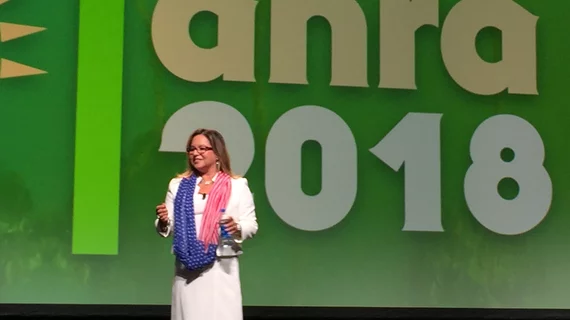AHRA 2018: Speakers at opening ceremony focus on leadership, teamwork, heroism
On Monday, July 23, AHRA President Angelic Bush, MSRS, CRA, RT, kicked off the opening ceremony of the AHRA 2018 Annual Meeting in Orlando with a few words of encouragement about the association’s humble beginnings and its lasting legacy.
“What started as a few colleagues getting together to share ideas over dinner is now one of the largest, most prominent, most influential organizations in all of healthcare,” Bush said, a smile on her face. “And why is that? Because as imaging leaders, you have stepped up and taken the lead in hospital operations. Your work in management, employee engagement, fiscal responsibility, quality, safety and innovation is recognized across healthcare as a force to be reckoned with.”
Bush then highlighted the importance of mentorship, recalling the crucial role it played in her own personal journey. Over the years, she said, mentors have helped her believe in her own potential, shown her the power of collaboration and taught her that you can’t take yourself too seriously.
“Mentorship happens every day with small acts and simple words,” she said. “And it can change the lives of the people around you.”
Bush then asked each attendee to reflect on their own mentors and offered the audience a call to action.
“You are the imaging industry’s leaders,” she said. “You are not bystanders. You cannot sit by and let others set policy standards and regulations about our business. You are in a position to do that business and change how imaging operations in the future, but you have to participate.”
As Bush’s speech came to a close, she asked Ed Cronin, AHRA’s CEO, to join her on stage. Back in March, Cronin announced that he was retiring after 14 years in the position to spend more time with his family, including his wife and his grandchildren. As he took the stage, the audience rose to its feet to celebrate Cronin’s impact on both AHRA and the medical imaging industry as a whole.
Cronin noted that has been a part of a lot of teams over the years. For a team to be great, he has learned, you need three main ingredients: a good coach, good players and a spirit that can bind everyone involved together.
“I can confidently say that AHRA has that spirit at every level” Cronin said. “I felt it during my first AHRA annual meeting and I know it’s still there in this room today. That’s why I’m confident that AHRA will continue to soar: I know you guys all always care for your profession, for your association and for each other.
What is a hero?
Keynote speaker Kevin Brown spoke next. Brown started off with a lot of laughs—his “resting face” had attendees in stiches—but then got more serious as he discussed how different people view terms such as “hero” and “heroic.”
People often describe heroes as “ordinary people who do extraordinary things,” Brown said, but he thinks that common sentiment is actually wrong.
“We’ve been conditioned to think about heroes and high performance in a very dangerous way,” he said. “If we buy into this idea that heroes are ordinary people who do extraordinary things by default, we’ve pushed integrity outside of ourselves and given ourselves to be ordinary most of the time.”
In fact, Brown said, each person is quite extraordinary. We’re all unique, with our very own personality, gifts and character traits. There’s nothing ordinary about any of that. So, he realized, it’s actually the opposite of that common belief that is true.
“Heroes are extraordinary people who choose not to be ordinary,” he said. “‘Ordinary’ is a learned behavior. It is a conditioning process. It is the sum total of the habits you develop and the people you associate with. It is a choice that keeps extraordinary people from their best lives.”

